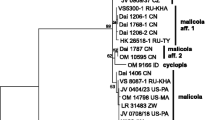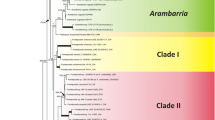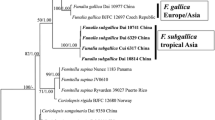Abstract
This study was focused on species of Peziza belonging to the “P. ammophila” complex, using both morphological and molecular approaches. Molecular and morphological analyses showed that several taxa are hidden under the name “ammophila” and, as a consequence, two additional species and one form are established: P. hellenica sp. nov., P. oceanica sp. nov. and P. ammophila f. megaspora f. nov. On the basis of the data that we have, these taxa seem to be related to some geographical areas; P. ammophila appears to be prevalent in northern, central and southern Europe, its f. megaspora is distributed in France and in the Netherlands, P. hellenica comes from Greece and P. oceanica from New Zealand. A cryptic species, not yet circumscribed satisfactorily, is described as P. deceptiva ad int. Moreover, the problem concerning the identification of P. ammophila is raised, the species is epitypified with a sequenced collection from Sicily (Italy) and a key to the species of the complex is provided.










Similar content being viewed by others
References
Andersson O (1950) Larger fungi on sandy grass heaths and sand dunes in Scandinavia. Bot Notiser Supplement 2:1–89, +tab. 1–9
Bon M (1970) Flore héliophile des macromycètes de la zone maritime picarde. Bull Soc Mycol France 86:79–213
Cooke MC (1876) New British fungi (cont.). Grevillea 5(34):56–64
Cooke MC (1879) Mycographia, seu icones fungorum. Williams and Norgate, London
Darriba D, Taboada GL, Doallo R, Posada D (2012) jModelTest 2: more models, new heuristics and parallel computing. Nat Methods 9(8):772. doi:10.1038/nmeth.2109
Dennis RWG (1960) British cup fungi and their allies. Ray Society, London
Dennis RWG (1981) British ascomycetes. Cramer, Vaduz
Dissing H (2000) Pezizales. In: Hansen L, Knudsen H (eds) Nordic macromycetes, vol 1. Nordsvamp, Copenhagen, pp 55–128
Donadini JC (1977) Le genre Peziza L. per Saint-Amans (1). Bull Soc Linn Provence 30:37–92, +8 tables
Donadini JC (1979) Le genre Peziza Linné per Saint-Amans (1ère partie). Doc Mycol 9(36):1–42
Donadini JC (1981) Le genre Peziza dans le sud-est de la France. Université de Provence, Marseille
Drummond AJ, Ashton B, Cheung M, Heled J, Kearse M, Moir R, Stones-Havas S, Thierer T, Wilson A (2010) Geneious 5.3. Home page at: http://www.geneious.com
Durieu De Maisonneuve MC (1848) Exploration Scientifique de l’Algérie. Imprimerie Impériale, Paris
Ellis MB, Ellis JP (1988) Microfungi on miscellaneous substrates. Croom Helm, London & Sydney
Felsenstein J (1985) Confidence limits on phylogenies: an approach using the bootstrap. Evolution 39:783–791. doi:10.2307/2408678
Gamundí IJ (1975) Fungi, Ascomycetes, Pezizales. Flora criptogámica de Tierra del Fuego 10(3):1–181
Gardes M, Bruns TD (1993) ITS primers with enhanced specificity for basidiomycetes—application to the identification of mycorrhizae and rusts. Mol Ecol 2:113–118. doi:10.1111/j.1365-294X.1993.tb00005.x
Gillet CC (1879) Les Discomycètes. de Broise, Alençon
Grelet LJ (1932–1959) Les discomycètes de France d’après la classification de Boudier, Réédition 1979. Société Botanique du Centre-Ouest, Royan
Häffner J (1993) Rezente ascomycetenfunde XIII. Rheinl-Pfälz Pilzj 3(2):108–145
Hansen K, Læssøe T, Pfister DH (2001) Phylogenetics of the Pezizaceae, with an emphasis on Peziza. Mycologia 93(5):958–990. doi:10.2307/3761760
Hansen K, Læssøe T, Pfister DH (2002) Phylogenetic diversity in the core group of Peziza inferred from ITS sequences and morphology. Mycol Res 106(8):879–902. doi:10.1017/S0953756202006287
Hansen K, LoBuglio KF, Pfister DH (2005) Evolutionary relationships of the cup-fungus genus Peziza and Pezizaceae inferred from multiple nuclear genes: RPB2, β-tubulin, and LSU rDNA. Mol Phylogenet Evol 36:1–23. doi:10.1016/j.ympev.2005.03.010
Hennings P (1906) Deutsche Südpolar-expedition, 1901–1903. Reimer, Berlin
Hohmeyer H (1986) Ein Schlüssel zu den europäischen Arten der Gattung Peziza L. Z Mykol 52(1):161–188
Katoh K, Misawa K, Kuma KI, Miyata T (2002) MAFFT: a novel method for rapid multiple sequence alignment based on fast Fourier transform. Nucleic Acids Res 30:3059–3066. doi:10.1093/nar/gkf436
Lambotte È (1888) La Flore Mycologique de la Belgique. Premier supplément: comprenant les Hyménomycètes, Pyrénomycètes, Discomycètes. Addition de 1070 espèces à la Flore de 1880. Mém Soc Roy Sci Liège Sér 2(14):1–350
Maas Geesteranus RA (1967) De fungi van Nederland 2a. Pezizales – deel I (Discinaceae, Helvellaceae, Morchellaceae, Pezizaceae, Rhizinaceae). Wetensch Meded Kon Ned Natuurhist Ver 69:1–72
Malençon G (1979) Nouvelles contributions a la flore mycologique du Maroc. II. Bull Soc Mycol Fr 95(2):119–137
Massee G (1895) British fungus flora, vol 8. Clowes & Sons, London
Medardi G (2006) Atlante fotografico degli Ascomiceti d’Italia. A.M.B. Fondazione Centro Studi Micologici, Vicenza
Medardi G, Lantieri A, Pfister DH, LoBuglio KF, Cacialli G (2012) Clarification of Peziza fimeti with notes on P. varia collections on dung. Mycotaxon 121:465–476. doi:10.5248/121.465
Miller MA, Pfeiffer W, Schwartz T (2010) Creating the CIPRES Science Gateway for inference of large phylogenetic trees. In: Proceedings of the Gateway Computing Environments Workshop (GCE), New Orleans, Louisiana, 14 November 2010. Institute of Electrical and Electronics Engineers. doi:10.1109/gce.2010.5676129
Moesz G (1912) Két érdekes homoki csészegombáról. Bot Közlem 11(5–6):196–201
Moesz G (1913) Über zwei interessante sandbewohnende Discomyceten. Bot Centralbl 122:563–564
Moser M (1963) Kleine Kryptogamenflora Band IIa. Ascomyceten (Schlauchpilze). Gustav Fischer Verlag, Stuttgart
Norman JE, Egger KN (1996) Phylogeny of the genus Plicaria and its relationship to Peziza inferred from ribosomal DNA sequence analysis. Mycologia 88:986–995
Norman JE, Egger KN (1999) Molecular phylogenetic analysis of Peziza and related genera. Mycologia 91:820–829
Oudemans CAJA (1889) Contributions à la Flore Mycologique des Pays-Bas. Ned Kruidk Arch 5:454–519
Patouillard N (1904) Énumération des champignons récoltés en Tunisie par M. de Chaignon en 1903 et 1904. Bull Soc Hist Nat Autun 17:144–157
Pennycook SR, Medardi G, Lantieri A, Cacialli G (2013) Proposal to conserve the name Peziza ammophila Durieu & Lév. 1848 against P. ammophila Saut. 1841 (Ascomycota: Pezizaceae). Taxon 62(3):628. doi:10.12705/623.19
Pouzar Z (1972) Sarcosphaera crassa (Santi ex Steud.) Pouz., the correct name for Sarcosphaera coronaria (Jacq. ex M.C. Cooke) J. Schroet. (Pezizaceae). Česka Mykol 26(1):32–36
Ridgway R (1912) Color standards and color nomenclature. Ridgway, Washington D.C.
Ronquist F, Teslenko M, van der Mark P, Ayres DL, Darling A, Höhna S, Larget B, Liu L, Suchard MA, Huelsenbeck JP (2012) MrBayes 3.2: efficient Bayesian phylogenetic inference and model choice across a large model space. Syst Biol 61:539–542. doi:10.1093/sysbio/sys029
Saccardo PA (1889) Sylloge Fungorum omnium hucusque cognitorum. Patavii 8:1–1143
Seaver FJ (1942) The North American Cup—fungi (Operculates). Supplement edition. Hafner, New York
Stamatakis A (2006) RAxML–VI–HPC: maximum likelihood-based phylogenetic analyses with thousands of taxa and mixed models. Bioinformatics 22:2688–2690. doi:10.1093/bioinformatics/btl446
Tamura K, Stecher G, Peterson D, Filipski A, Kumar S (2013) MEGA6: molecular evolutionary genetics analysis version 6.0. Mol Biol Evol 30:2725–2729. doi:10.1093/molbev/mst197
Teodorowicz F (1936) Grzyby wyższe polskiego wybrzeża. Toruń, Warsaw
Thiers B [continuously updated]. Index herbariorum: a global directory of public herbaria and associated staff. New York Botanical Garden’s Virtual Herbarium. Home page at: http://sweetgum.nybg.org/ih/. Accessed 21 March 2016
Trail JWH (1893) Peziza ammophila, D. and M. Ann Scott Nat Hist 5:37–40
White TJ, Bruns T, Lee S, Taylor JW (1990) Amplification and direct sequencing of fungal ribosomal RNA genes for phylogenetics. In: Innis MA, Gelfand DH, Sninsky JJ, White TJ (eds) PCR protocols: a guide to methods and applications. Academic Press, New York, pp 315–322. doi:10.1016/b978-0-12-372180-8.50042-1
Acknowledgements
We are very grateful to the keepers of the Institutional Herbaria AMB, HMA, L, LIP, MCVE, NSW, PDD, TAAM and UPS for the loan of collections, and to E. Bizio and N. Van Vooren for putting their collections at our disposal. Moreover, we thank Dr. G. Thijesse (L), Dr. P.A. Moreau (LIP), Prof. P.R. Johnston (PDD), Dr. Parmasto † (TAAM) and Dr. S. Ryman (UPS) for their permission to carry out molecular analyses on their samples. We are also indebted to Prof. D.H. Pfister for his helpful advice on some taxonomic problems, Prof. G. Consiglio for the Latin translation of the original diagnoses, and C. Papetti and Prof. S. Pennycook for their valuable suggestions about the nomenclature.
Finally, we want to express our gratitude to M. Gkilas and L. Kottis, who provided us with the samples and the images in situ of P. hellenica, to Prof. P.R. Johnston for the permission to use the images of P. oceanica and to E. Grilli for improving the English text.
Author information
Authors and Affiliations
Corresponding author
Ethics declarations
Conflict of interest
The authors declare that they have no conflict of interest.
Additional information
Section Editor: Gerhard Rambold
Electronic supplementary material
Below is the link to the electronic supplementary material.
ESM 1
Peziza hellenica - a, b: Images of the habitat of the species; c, d: apothecia in situ (Photo L. Kottis). Peziza oceanica - e, f: Images of the habitat of the species; g, h: apothecia in situ (Photo P.R. Johnston) (JPG 12.6 mb)
Rights and permissions
About this article
Cite this article
Vizzini, A., Lantieri, A., Medardi, G. et al. Phylogeny and morphology of the Peziza ammophila complex (Pezizales, Ascomycota), with description of two new species and a new form. Mycol Progress 15, 883–901 (2016). https://doi.org/10.1007/s11557-016-1213-9
Received:
Revised:
Accepted:
Published:
Issue Date:
DOI: https://doi.org/10.1007/s11557-016-1213-9




